|
Importing a site or objects |

|

|

|

|
After you export some site or objects using the Export site wizard or Export objects wizard, you can import it using the Import site or objects wizard. Before you start the wizard, you need to copy your exported packages into the <web project>\CMSSiteUtils\Import folder.
Importing a site
Go to Site Manager -> Sites and click Import site or objects.
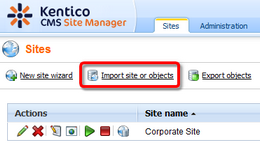
In the first step, a list of Import packages located in <web project>\CMSSiteUtils\Import is displayed. If you want to add an import package to the folder, do it and click the Refresh (![]() ) link. The new package will be displayed in the list.
) link. The new package will be displayed in the list.
Using the two radio buttons below, you can determine if duplicate items will also be preselected or if only new items will be selected for import in the next step.
Choose to import the appropriate package and click the Next button.
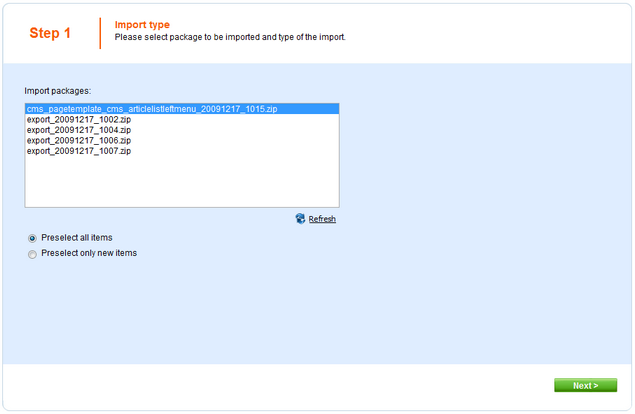
Step 2 will be displayed only when you are importing a site package. In case that you are importing a package containing only global objects, Step 3 will be displayed instead.
You have the following two options in Step 2:
| • | Import a new site - when chosen, a new site will be created based on the contents of the package; you have to enter the site's display name, code name and domain name |
| • | Import objects into an existing site - when chosen, contents of the package will be imported into the site chosen by the check-box below |
Click the Next button to proceed to the next step.
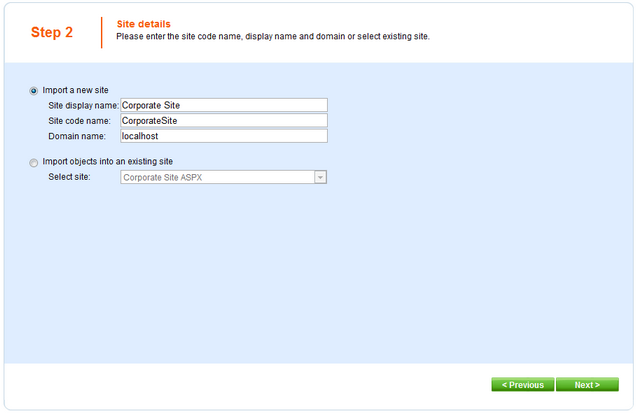
In Step 3, you can select which of the objects from the package will be imported. The tree on the left represents object categories. These reflect the sections of the administration interface under that the objects can be found. By selecting a category, a set of check boxes appears in the right part of the screen, letting you select which objects will be imported. Objects that already exist on the target server are marked with *. If you leave the check-box of such object checked, this existing object will be overwritten with the newly imported one.
If you select the root of the tree (Import objects), a number of global choices will be offered to you. The Global selection section allows you to select all, only new or no objects at all. You can also load the default selection, so that all selection changes you've done will be rolled back. The Import settings section contains other basic import settings:
| • | Update site definition - displayed only when importing to an existing site; if enabled, all settings stored as a part of the site object will be updated with those contained in the package; these settings are contained in the Site\cms_site.xml file inside the export package |
| • | Assign all objects to the imported site (recommended) - if checked, all imported site-related objects will be assigned to the imported site |
| • | Run the site after import - if checked, the imported site will be run after the import process finishes |
| • | Delete incomplete site when import fails - if checked, incompletely imported site will be deleted when the import process fails |
| • | Import files (recommended) - some objects in the database are linked with physical files in the file system; if you check this check-box, such files contained in the package will be imported too |
| • | Overwrite system queries - if checked, system queries will be overwritten by those contained in the package |
| • | Do not import objects where parent object is missing - if checked, child objects whose parent objects are not found will be skipped and the import process will continue |
| • | Import tasks (recommend) - if checked, delete tasks (incremental deployment) included in the package will be performed |
|
Overwrite system queries
This option is displayed only when importing from version older than the current one; if checked, all queries from the package will be imported and will overwrite the current ones; if the package contains your own custom queries that you added to the system, it is necessary to have this option enabled.
|

The following categories contain extra options to be set:
Documents
| • | Import new documents - if checked, documents will be imported (when importing into an existing site, only new documents will be imported) |
| • | Import document relationships - if checked, document relationships will be imported |
| • | Import document level permissions - if checked, document security settings made in CMSDesk will be imported |
| • | Import blog comments - if checked, blog comments will be imported |
|
Please note
When importing into an existing site, only new documents can be imported. Modified documents that are already present on the target server will not be overwritten.
|
BizForms
| • | Import BizForms data - if checked, BizForms data included in the package will be imported together with the BizForms |
Forums
| • | Import forum posts - if checked, forum posts included in the package will be imported together with the forums |
Message boards
| • | Import board messages - if checked, board messages included in the package will be imported together with the message boards |
Media libraries
| • | Import media files - if checked, media files (stored in database) included in the package will be imported together with the media libraries |
| • | Import physical files - if checked, physical files (stored in the file system) included in the package will be imported together with the media libraries |
If you have the "Log export tasks" option enabled in Site Manager -> Settings -> Content Staging, a list of tasks may also be displayed under the objects list. This happens when some global objects were deleted (just as the two Web part containers in the screenshot below). If you leave the check-boxes checked, these objects will be deleted on the target server.
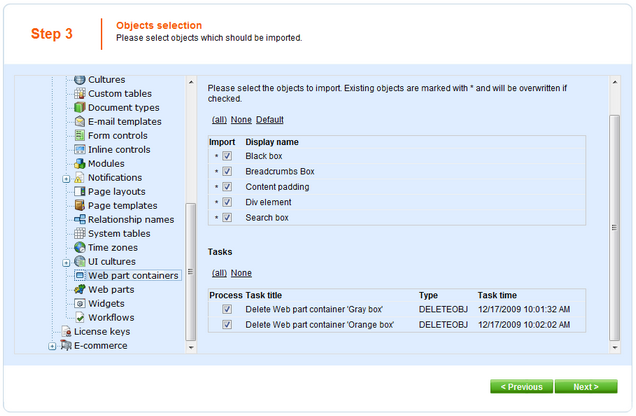
An import log will be displayed, showing the progress of importing (you can abort importing by clicking the Cancel button any time). Click the Finish button. You will be redirected back to Site manager -> Sites, where the newly imported site will be running.
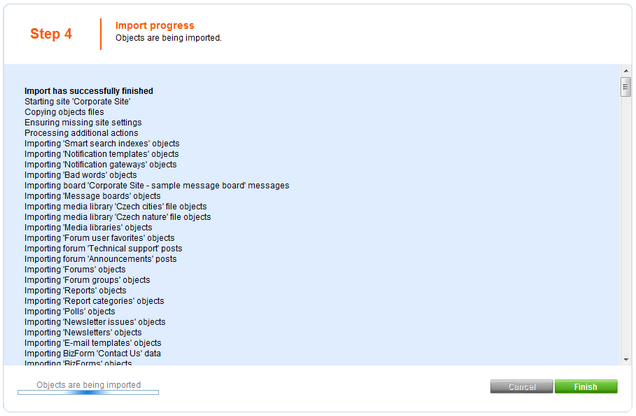
|
Please note
Packages from different versions of Kentico CMS have different structure. When importing packages from an older version of Kentico CMS to a newer one, structure of the package is always converted to the newer format automatically. Please pay special attention when importing Form user control, Inline control and Web part objects from older packages. If possible, avoid overwriting your current objects of these types with objects from older packages, as it may cause incompatibility problems. |
Conflicts of running sites
If the imported site uses the same domain name or alias as one of the web sites that already run on your server, you may get an error message at the end of the import:
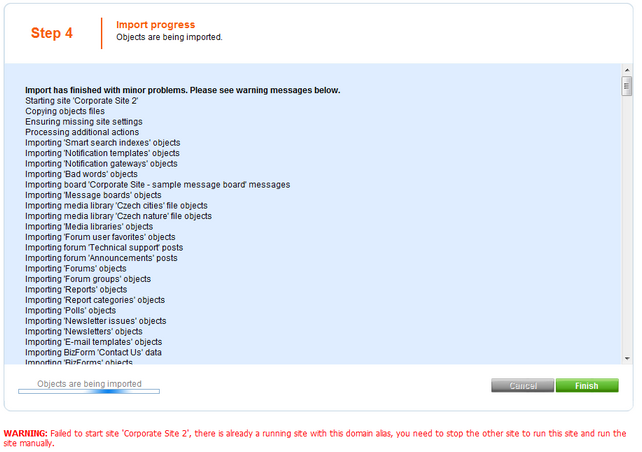
In such case, you need to go to the Sites section, change the domain name or domain alias and start the new web site manually using the Start site button.
|
Application restart At the end of the import process, you may get the following error message:
"Application has been restarted and the logging of the import process has been terminated. Please see context help in this section for more details and how to solve this issue."
If so, you will have to finish the import process manually:
- cms_webpart - cms_cssstylesheet - cms_documenttype - cms_formusercontrol - cms_inlinecontrol - cms_pagetemplate - Global Also extract the <package>\Data\Site folder.
|
Page url: http://devnet.kentico.com/docs/devguide/index.html?importing_a_site_or_objects.htm